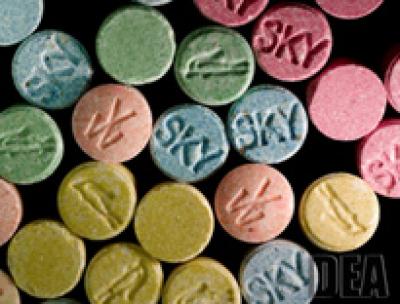Ecstasy
Ecstasy, also called MDMA, is a partial derivative of amphetamine and has effects similar to others in the amphetamine group. It is sometimes classified as a hallucinogen. Most individuals who use Ecstasy also use other drugs. Other names for Ecstasy include MBDB, MDE, MDA, MDEA, MDMA, XTC, E, X, Beans, Adams, Hug Drug, Disco Biscuit, Go and 2CB.
MDMA (3,4-methylenedioxymethamphetamine) is a synthetic, psychoactive drug chemically similar to the stimulant methamphetamine and the hallucinogen mescaline. MDMA is an illegal drug that acts as both a stimulant and psychedelic, producing an energizing effect, as well as distortions in time and perception and enhanced enjoyment from tactile experiences.
Adolescents and young adults use it to promote euphoria, feelings of closeness, empathy, sexuality and to reduce inhibitions. It is considered a "party drug" and obtained at "rave" or "techno" parties. However, its abuse has expanded, to include other settings outside of the rave scenes, such as a college campus.
Although MDMA is known universally among users as ecstasy, researchers have determined that many ecstasy tablets contain not only MDMA but also a number of other drugs or drug combinations that can be harmful as well. Adulterants found in MDMA tablets purchased on the street include methamphetamine, caffeine, the over-the-counter cough suppressant dextromethorphan, the diet drug ephedrine, and cocaine. Also, as with many other drugs of abuse, MDMA is rarely used alone. It is not uncommon for users to mix MDMA with other substances, such as alcohol and marijuana.
In high doses, MDMA can interfere with the body’s ability to regulate temperature. On rare but unpredictable occasions, this can lead to a sharp increase in body temperature (hyperthermia), resulting in liver, kidney, and cardiovascular system failure, and death. Because MDMA can also interfere with its own metabolism, (breakdown within the body): potentially harmful levels can be reached by repeated drug use within short intervals.
Users of MDMA face many of the same risks as users of other stimulants such as cocaine and amphetamines. These include increases in heart rate and blood pressure, a special risk for people with circulatory problems or heart disease, and other symptoms such as muscle tension, involuntary teeth clenching, nausea, blurred vision, faintness, and chills or sweating.
Almost 60 percent of people who use MDMA report withdrawal symptoms, including fatigue, loss of appetite, depressed feelings, and trouble concentrating.
Research in animals links MDMA exposure to long-term damage to neurons that are involved in mood, thinking, and judgment. A study in nonhuman primates showed that exposure to MDMA for only 4 days caused damage to serotonin nerve terminals that was evident 6 to 7 years later. While similar neurotoxicity has not been definitively shown in humans, the wealth of animal research indicating MDMA’s damaging properties suggests that MDMA is not a safe drug for human consumption.


